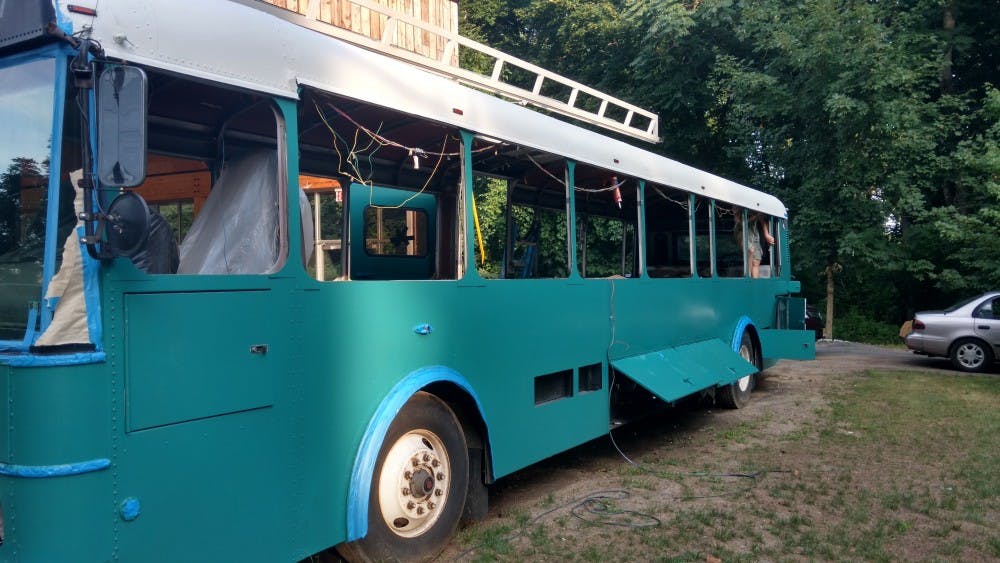While in high school, Nicolas Viglucci ’19 won an online auction for a bus, but his father cancelled the sale since Viglucci had neither a design plan nor the funding to realize his dream of renovating it. Five years later, Viglucci has received generous funding from High Meadows Foundation Sustainability Fund and Project X Innovation Fund to finally build his dream - a tiny home inside a bus at the University.
Now, on weekends, Viglucci spends his free time turning a $2700 1998 Thomas Transit-Liner school bus into a tiny energy-efficient house. As a mechanical and aerospace engineering major who is also pursuing a certificate in sustainable energy, Viglucci is deeply passionate about hands-on sustainability efforts.
Viglucci explained he has always been interested in sustainable energy and even intends to pursue a career in the field, largely because he is from Miami, Fla. The region, known for drastic flooding and other devastating effects of climate change, was a compelling reason for his passion. Viglucci explained that the project fits neatly into his interests, and is flexible enough to fit into a college lifestyle.
“The idea is that I’ll be able to park it in a driveway for 100 bucks a month, which is way cheaper than rent, work for a couple of years to pay off loans, and after that, drive around the country and live wherever for a little while,” Viglucci said.
“Our first deadline for High Meadows was Nov. 15, and we’re about a third of the way done,” Viglucci said with sheepish chuckle. However, Viglucci and the team plan to finish the entire project by the end of this academic year.

On average, Viglucci spends between 10 and 13 hours each week working on the bus behind Frick Chemistry Laboratory at the Architecture Laboratory, an offshoot of the School of Architecture space designed for collaboration between architects and engineers. During the summer, he worked as long as eight to nine hours every day, mostly by himself, although he occasionally recruited help from friends for more strenuous tasks like painting the exterior or grinding away rust.
While Viglucci uses his own background in engineering to design the electrical systems, he often pulls inspiration and advice from a variety of sources, including his advisor, Forrest Meggers, assistant professor in the Andlinger Center for Energy and the Environment. Viglucci also receives help from his peers, such as Eric Teitelbaum GS, a graduate student from the civil and environmental engineering department who has experience working with treehouses, and Coleman Merchant ’19, who is also concentrating in mechanical and aerospace engineering.
The interior design inspiration comes from the blog “Hank Bought a Bus,” which is run by Hank Butitta, a University of Minnesota graduate who converted a bus for his master’s final project.
The two main components that will distinguish Viglucci's living space from other tiny houses will be its cooling system and lithium ion solar system. Forty-eight percent of the energy consumed by homes in the United States is used for heating and cooling, according to the U.S. Department of Energy, so Viglucci is searching for ways to be more energy and cost efficient. He hopes to computerize the heating and cooling system through constant monitoring so that the two functions can happen independently without requiring intervention by the homeowner.

Moreover, while most people currently use lead acid batteries to power their houses, a lithium ion solar system, though more difficult to implement, is more environmentally friendly. Consequently, Viglucci and his team aim to make both systems — particularly the lithium ion solar system — more accessible and affordable.
Despite aiming to solve engineering inefficiencies in the long run, Viglucci himself has encountered obstacles, most of which include “weather, flaky people, and technical difficulties.” While he expressed frustration with annoyances such as squalls while trying to paint the exterior, he has delighted in small successes.
“Once I finish one phase, it’s really satisfying,” Viglucci said. “Putting together a lot of the photos has been particularly satisfying because day to day it doesn’t feel like progress has been made.”
The general public can also view the progress and pictures through his open source website, putt-putt-the-bus.com. Viglucci said that this independent project is still nameless — even the acronym “putt putt” doesn’t stand for anything. Yet once the bus is finished, Viglucci will make it available for sustainability events on campus and open houses on campus to demonstrate the progress of his work.








